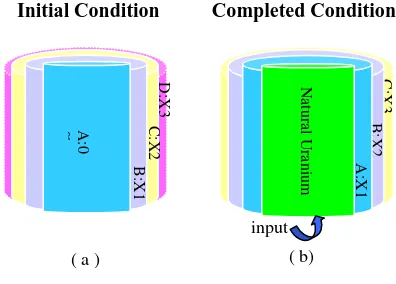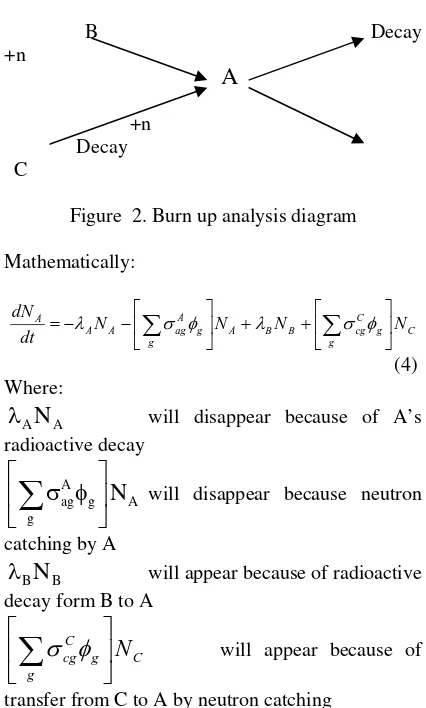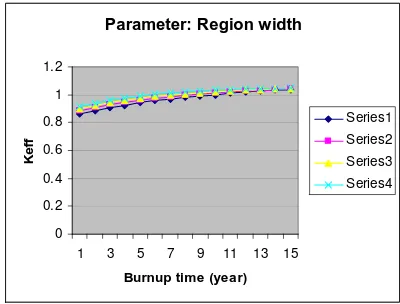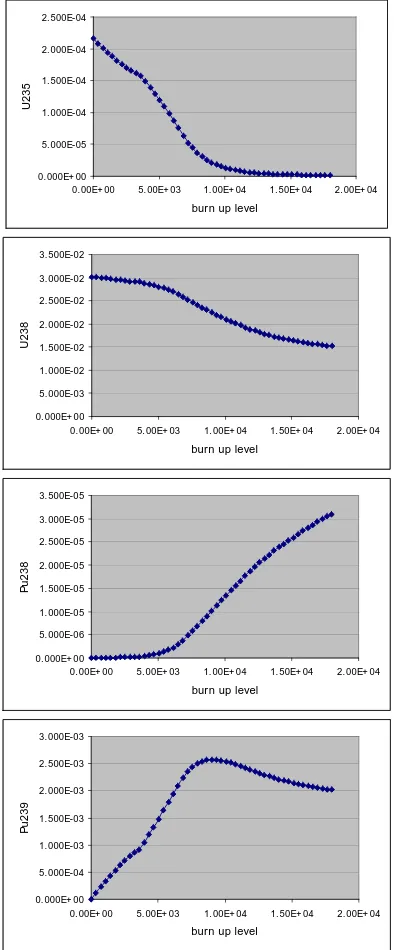International Conference on Advances in Nuclear Science and Engineering in Conjunction with LKSTN 2007 (257-261)
Design Study of Long Life Pb-Bi Cooled Reactors With Natural Uranium
as Fuel Cycle Input Using Radial Fuel Shuffling Strategy
Rida Siti NM1 and Zaki Su’ud2
1
Bandung Institute of Technology, Bandung, Indonesia
2
Bandung Institute of Technology, Bandung, Indonesia Email: [email protected]
Abstract
DESIGN STUDY OF LONG LIFE Pb-Bi COOLED REACTORS WITH NATURAL URANIUM AS FUEL CYCLE INPUT USING RADIAL FUEL SHUFFLING STRATEGY. In this study conceptual design study of Pb-Bi cooled fast reactors which fuel cycle need only natural uranium input has been performed. In this design the reactor cores are subdivided into several parts with the same volume. The region with natural uranium is put in the central core while the outer region is arranged with increasing plutonium content. But in some cases region with natural uranium content can be put in the most outer part of the core. The arrangement of the plutonium content considers the criteria that the fuel in the certain part must be fit for fresh fuel in the next higher enrichment region. Therefore at the end of a long life operation we just need to supply natural uranium fuel to the blanket region and move other regions properly to the next regions. As an example using SRAC and FI-ITB CH code system we have a core with 15-20 years life time per sub cycle.
Keywords: Pb-Bi cooled fast reactors, Plutonium, Natural uranium
1. Introduction
3,5,6Iran’s uranium enrichment program emerged many problems and therefore become an international crisis. One of Iran’s reasons to keep ongoing the uranium enrichment program is to guarantee their nuclear power plant fuel that will be built. Iran was worried that in the future, after they have already built the power plant, the fuel supply will be disturbed by the international politic condition.
This paper was a preliminary study to see any possibilities of designing a fast reactor which needs only a fertile fuel such as natural uranium or natural thorium after the reactor started-up. In general, the reactor was divided into several regions with same volume. Furthermore, fuel transfer will also occurred after a certain period of operation. Fertile fuel will come to the first region, while other region will move one stage. Detail explanations will be given at the design concept chapter.
Benefit from this concept is, that we can provide nuclear fuel our self without any uranium enriching process, which also avoid international controversy like Iran case.
2. Design Concept
5In this study we use a cylinder nucleus reactor which divided into several regions with same volume, as given in Figure 1 below.
A:0
%
C:X3
B:X2
A:X1
Natural U
ranium
Initial Condition Completed Condition
( b) ( a )
input
D:X3
C:X2
[image:1.612.338.536.445.587.2]B:X1
Figure 1. Explanation of reactor nucleus that installed in this study
then plutonium accumulation in region A will be equivalent with x1, plutonium in region B will be equivalent with x2 and plutonium in region C will equivalent with x3. Thus, region A, B and C are transferred one step into their outer neighbor region (which occupied before by B, C and D), while in the center region filled-up with new fertile natural uranium. Thus, the reactor is ready for the next operation period.
Analysis chapter in this study was done in three steps. First step is parameter survey, to acquaint some dominant parameters such as width of each nucleus region, average nucleus power density, and core height. Then we do optimization stage one without introducing fission product (FP) at the initial operation, and optimization stage three by introducing FP at the initial operation.
In this study we have calculation in 2 dimension diffusion multi-group that combined with burn up calculation. In implementation we use SRAC and FI-ITB CH computer code for this analysis. Mathematical formulation in the calculation is as below:
2.a Multi-group diffusion equation in steady state condition:
9 9
,
D
( , )
r t
rg g( ,
r t
−∇ ∇Ψ
r
r
r
+ ∑ Ψ
r
)
=
1 1 1 1
1 1
( , )
1 1( , )
G G
g
fg g sg g g
g g
eff
x
r t
r t
k
=ν
= →=
∑ ∑ Ψ
r
+ ∑ ∑
Ψ
r
(1)
Where:
g : shows the number of energy group
D : diffusion constant
Σr : macroscopic cross section removal
Σs : macroscopic cross section scattering
Σf : macroscopic cross section fission
v : Average number of neutron from each fission
φ : Neutron flux
χg : number of neutron from fission come into
group g
keff : multiplication factor
This equation was known as multi-group diffusion equation and need a mathematical operation to solve so that we can get neutron distribution and reactor nucleus power.
2.b. Burn up Analysis
Furthermore, we have to do the burn up analysis to gain information about fuel composition changes.
B Decay
[image:2.612.329.542.131.485.2]+n +n Decay
A
CFigure 2. Burn up analysis diagram
Mathematically: C g g C cg B B A g g A ag A A A N N N N dt dN ⎥ ⎦ ⎤ ⎢ ⎣ ⎡ + + ⎥ ⎦ ⎤ ⎢ ⎣ ⎡ − − = λ
∑
σ φ λ∑
σ φ (4) Where: A AN
λ
will disappear because of A’sradioactive decay
A g
g A ag
⎥
N
⎦
⎤
⎢
⎣
⎡
φ
σ
∑
will disappear because neutroncatching by A
B B
N
λ
will appear because of radioactivedecay form B to A
C g
g C
cg
⎥
N
⎦
⎤
⎢
⎣
⎡
∑
σ
φ
will appear because oftransfer from C to A by neutron catching
This equation was applied to all trans-uranium nucleus reaction which is relevant as shown in Figure 2. Burn up equation is an ordinary differential equation coupled order 1 and usually solved concurrently with the multi-group diffusion equation. Neutron flux that results from multi-group diffusion was used for the burn up analysis, thus composition change by the burn up composition in time need to be introduced in the calculation of the diffusion constants, cross section reaction, etc. Sum of heavy nuclei that involved was 29, from U-234 until Cm-249.
3. Result and Discussion
At the first step we have the parameters survey with basic parameter as below:
Table 1. nucleus parameter reference for parameters survey
Parameter Value
Power 600 MWth (reference)
Fuel UN-PuN Enrichment (reg.
A/B/C/D)
0% / 6% / 8% / 10%
Coolant Pb-Bi Active nucleus height 150 cm (reference)
Active nucleus radius 100 cm (reference)
At the first parameter survey, the value of power was changed with other parameter remain constant so that the power density was changed. The result was shown in Figure 3 and table 2.
Parameter : power density
0.8 0.85 0.9 0.95 1 1.05 1.1
1 3 5 7 9 11 13 15
Burnup time (year)
Ke
ff
[image:3.612.86.307.104.222.2]Series1 Series2 Series3 Series4
Figure 3. keff value alteration along the burn
up time for various power: 200 MWt (series 1), 400 MWt (series 2), 600 MWt (series 3) and 800 MWt (series 4)
It is shows that the increase of power density will cause the multiplication factor grow faster, this is mainly caused by the production ratio compare than Pu-241 destruction because at initial condition, the plutonium to be taken on from PWR. Table 2 shows that by the increasing of the power density, then plutonium accumulation in nucleus part A become higher because neutron flux also become higher so that the neutron catching reaction by the U-238 will also have a higher rate. Same condition also occurred at B, C and D part, where the increasing of power density will escalate the fuel (plutonium) production rate.
Power density increasing will also escalate the burn up value at the end of operation period. Thus the result of nucleus radius parameter was shown by Figure 4 and table 3.
Parameter: Region width
0 0.2 0.4 0.6 0.8 1 1.2
1 3 5 7 9 11 13 15
Burnup time (year)
Ke
ff
[image:3.612.90.291.293.441.2]Series1 Series2 Series3 Series4
Figure 4. keff value alteration along the
burn up time for various radius: 80 cm(series 1), 90 cm(series 2), 100 cm(series 3) and 110 cm(series 4)
It is shown that the increase of the core radius with constant power level increase the effective multiplication factor at the beginning and during burnup. But there is also a slite power density decrease so that in the first region it slightly decrease the plutonium accumulation rate.
Parameter : Axial heigh
0.8 0.85 0.9 0.95 1 1.05 1.1
1 3 5 7 9 11 13 15
Burnup time (year)
K e
ff
Series1 Series2 Series3 Series4
Figure 5. keff value alteration along the burn
up time for various nucleus height: 130 cm(series 1), 140 cm(series 2), 150 cm(series 3) and 160 cm(series 4)
It is shown that the increase of the core height with constant power level increase the effective multiplication factor at the beginning and during burnup. It is similar to that of core radius parameter. And there is also a slite power density decrease so that in the first region it slightly decrease the plutonium accumulation rate.
[image:3.612.332.534.374.524.2]region, we got some designs which can fulfill the criteria in in study.
[image:4.612.337.534.226.701.2]An example of optimal design is shown in Table 6.
Table 6. Nucleus parameter with considering FP
Parameter Value
Power 900MWth (reference)
Fuel UN-PuN Enrichment
(A/B/C/D/E)
7% /9.75% /10.75% / 4.25%/0%
Coolant Pb-Bi Active nucleus
height
150 cm (reference)
Active nucleus radius
105 cm (reference)
Using the above parameters we got the design with initial multiplication factor slightly more than 1.0 and at the EOL became 1.06.
4. Conclusion
From the parametric survey results is is shown that higher power level more than (150 W/cc) is better to reach the ideal condition for long lfie nuclear reactors with only natural uranium as fuel cycle input.
In general the concept can be achieved by dividing the core into several parts with equal volume and the fuel history is started from the first region, then moved to the second region, third region etc. till final region every certain long life operation without refueling and shuffling. Pre irradiation of blanket region outside the active core significantly improve criticality condition especially at the BOL.
Acknowledgment
Author thanks to Mr. Zaki Su’ud for all of his supports and to all crew of nuclear reactor laboratory, physics study program of Bandung Institute of Technology.
References
1. Duderstadt, James J., 1976. Nuclear Reactor
Analysis, New York: John Wiley & Sons.
2. Okumura, Keisuke, 2002. The Comprehensive
Neutronics Calculation Code System,
JAERI.Report
3. Waltar, Alan E. dan Albert B. Reynolds, 1980.
Fast Breeder Reactors, New York: Pergamon
Press.
4. Laboratorium Nuklir, FI-ITBCHI Program
Sistem Simulasi Reaktor Nuklir. Bandung: ITB.
5. Rida siti NM, Studi Desain Reaktor Cepat Berpendingin Pb-Bi yang Hanya Memerlukan Input Uranium Alam dalam Siklus Operasinya, Skripsi S1, ITB, 2006
6. www.iaea.org
Appendix
Number density of important materials for each burn up level
0. 000E+ 00 5. 000E-05 1. 000E-04 1. 500E-04 2. 000E-04 2. 500E-04
0. 00E+ 00 5. 00E+ 03 1. 00E+ 04 1. 50E+ 04 2. 00E+ 04
burn up level
U
2
3
5
0. 000E+ 00 5. 000E-03 1. 000E-02 1. 500E-02 2. 000E-02 2. 500E-02 3. 000E-02 3. 500E-02
0. 00E+ 00 5. 00E+ 03 1. 00E+ 04 1. 50E+ 04 2. 00E+ 04
burn up level
U
2
3
8
0. 000E+ 00 5. 000E-06 1. 000E-05 1. 500E-05 2. 000E-05 2. 500E-05 3. 000E-05 3. 500E-05
0. 00E+ 00 5. 00E+ 03 1. 00E+ 04 1. 50E+ 04 2. 00E+ 04
burn up level
P
u
2
3
8
0. 000E+ 00 5. 000E-04 1. 000E-03 1. 500E-03 2. 000E-03 2. 500E-03 3. 000E-03
0. 00E+ 00 5. 00E+ 03 1. 00E+ 04 1. 50E+ 04 2. 00E+ 04
burn up level
P
u
2
3
9
0. 000E+ 00 1. 000E-04 2. 000E-04 3. 000E-04 4. 000E-04 5. 000E-04 6. 000E-04 7. 000E-04 8. 000E-04 9. 000E-04 1. 000E-03
0. 00E+ 00 5. 00E+ 03 1. 00E+ 04 1. 50E+ 04 2. 00E+ 04
burn up level
P
u
2
4
0
0. 000E+ 00 2. 000E-05 4. 000E-05 6. 000E-05 8. 000E-05 1. 000E-04 1. 200E-04
0. 00E+ 00 5. 00E+ 03 1. 00E+ 04 1. 50E+ 04 2. 00E+ 04
burn up lev el
P
u
2
4
1
-5. 000E-06 0. 000E+ 00 5. 000E-06 1. 000E-05 1. 500E-05 2. 000E-05 2. 500E-05 3. 000E-05 3. 500E-05 4. 000E-05 4. 500E-05 5. 000E-05
0. 00E+ 00 5. 00E+ 03 1. 00E+ 04 1. 50E+ 04 2. 00E+ 04
burn up lev el
P
u
2
4



